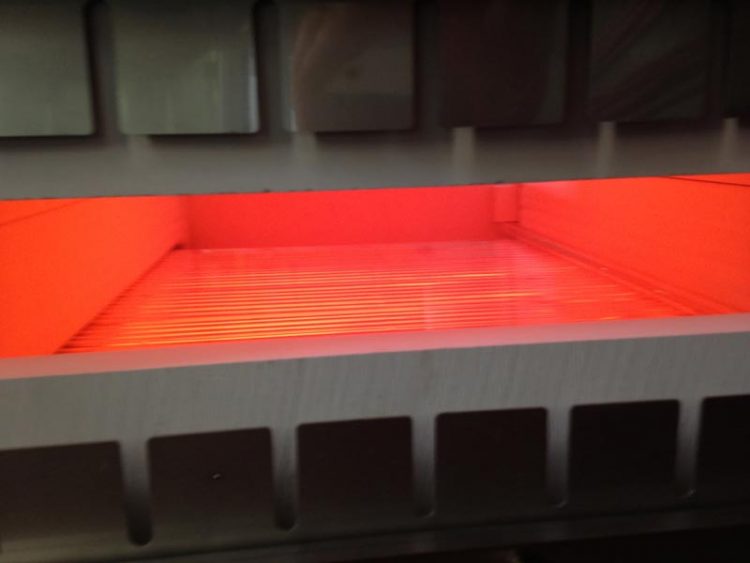Extremely efficient heating of metals with the MAX infrared oven from Heraeus

A MAX infrared oven in continuous operation Copyright Heraeus Noblelight 2015
Heraeus Noblelight offers the “MAX” infrared oven for heating process requiring very high temperatures. These ovens combine infrared radiation with convection and extremely high reflection. As a result, they are much superior to conventional industrial ovens.
They can be matched exactly to the process, which makes them more robust and stable. This allows capacity to be increased and quality to be improved. And these more efficient ovens save space, time and energy. Heraeus Noblelight will show infrared systems for metal processing on Stand C01 in Hall 9 at the Thermprocess Exhibition in Duesseldorf from 16 to 20 June.
In order to change the structure of metals, such as complex aluminum trims in motor vehicles, it is necessary to heat aluminum or magnesium components to very high temperatures. The heating of highly reflective metals is a real challenge for conventional technologies.
Up to 90% of the energy input can be lost by reflection or transmission. Thanks to the new MAX infrared technology, an energy efficiency of up to 90% can now be achieved for these tasks, depending on the particular application and the oven design.
Tests with various customers in our in-house Applications Centre have delivered very impressive results. Compared with conventional electrical heating methods, the heating process with a MAX oven was three times faster for metals. At the same time, energy consumption was only one fifth.
Advantages over standard ovens By Using QRC® Material
Tests have shown clear advantages of MAX ovens with QRC over conventional ovens using fireclay as the insulation material. Unlike conventional ovens, MAX ovens can be used in a continuous process, as the process chamber is made completely of quartz glass, which makes the oven resistant to thermal shock and a smaller, more compact oven is possible for the same power rating.
With a MAX infrared oven, the oven inside is comprised exclusively of quartz glass including QRC® nanoreflectors. The QRC® (Quartz Reflective Coating), developed by Heraeus is essentially an opaque, white, quartz glass. The nanostructure imparts a diffuse reflective capability to the material, resulting in a very high homogeneity of the temperature field in the oven.
In addition, quartz glass is also very clean, which is very important in the manufacture of items such as sensors and other sensitive parts in the car industry.
MAX – Exactly Tailored To Customer Needs
MAX infrared systems are flexibly tailored to meet customer requirements, in order to achieve the highest possible energy-efficiency for the process in question.
All MAX infrared ovens share a compact design and construction, so that the input energy is used more efficiently because the infrared radiation is optimally reflected within the oven, while the natural convection is also used.
As a result, process times can be shortened, which significantly increases energy efficiency and reduces operating costs. MAX infrared ovens provide systems solutions. Computer simulation at the design phase also helps to ensure energy efficiency.
MAX oven elements can be arranged one behind the other in a modular fashion. They can then be individually controlled, making possibly very fast product change-over. The compact ovens can also be combined with conveyor systems.
Heraeus, the technology group headquartered in Hanau, Germany, is a leading international family-owned company formed in 1851. With expertise, a focus on innovations, operational excellence and an entrepreneurial leadership, we strive to continuously improve our business performance.
We create high-quality solutions for our clients and strengthen their competitiveness in the long term by combining material expertise with technological know-how. Our ideas are focused on themes such as the environment, energy, health, mobility and industrial applications. Our portfolio ranges from components to coordinated material systems which are used in a wide variety of industries, including the steel, electronics, chemical, automotive and telecommunications industries.
In the 2014 financial year, Heraeus generated product revenues of €3.4 bn and precious metal revenues of €12.2bn euros. With around 12,600 employees worldwide in more than 100 subsidiaries in 38 countries, Heraeus holds a leading position in its global markets.
Heraeus Noblelight GmbH with its headquarters in Hanau and with subsidiaries in the USA, Great Britain, France, China and Australia, is one of the technology- and market-leaders in the production of specialist light sources and systems. In 2014, Heraeus Noblelight had an annual turnover of 137.3 Million € and employed 884 people worldwide. The organization develops, manufactures and markets infrared and ultraviolet emitters, systems and solutions for applications in industrial manufacture, environmental protection, medicine and cosmetics, research, development and analytical measurement techniques.
For further information, please contact:
Technical: Heraeus Noblelight GmbH
Reinhard-Heraeus-Ring 7
D-63801 Kleinostheim
Tel +49 6181/35-8545, Fax +49 6181/35-16 8545
E-Mail hng-infrared@heraeus.com
Press: Dr. Marie-Luise Bopp
Heraeus Noblelight GmbH,
Abteilung Marketing/Werbung
Tel +49 6181/35-8547, Fax +49 6181/35-16 8547
E-Mail marie-luise.bopp@heraeus.com
www.heraeus-noblelight.com
Media Contact
All latest news from the category: Trade Fair News
Newest articles

Silicon Carbide Innovation Alliance to drive industrial-scale semiconductor work
Known for its ability to withstand extreme environments and high voltages, silicon carbide (SiC) is a semiconducting material made up of silicon and carbon atoms arranged into crystals that is…

New SPECT/CT technique shows impressive biomarker identification
…offers increased access for prostate cancer patients. A novel SPECT/CT acquisition method can accurately detect radiopharmaceutical biodistribution in a convenient manner for prostate cancer patients, opening the door for more…

How 3D printers can give robots a soft touch
Soft skin coverings and touch sensors have emerged as a promising feature for robots that are both safer and more intuitive for human interaction, but they are expensive and difficult…





















